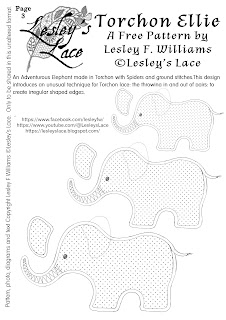Yes, I have got the order a bit mixed up but it will sort itself out in time.
This is a little elephant design I created from a simple outline, dropped a dotted grid in and drew the stitches on so I could see where I would need to add and take out threads. This is all part of the 'Muaiga' (made up as I go along) lace making ethic. Designers work in so many different ways, I doubt I have made two pieces of lace the same way twice, always tweaking and experimenting. These are some of my thoughts as I worked on this elephant.
I like to use a three or four pair passive trail when working on organic shapes, or 'floral' as it is called in Bobbin Lace, even when there are no flowers involved. This trail hides and carries extra threads and is handy to lay in new pairs when using up unjoined thread end bobbins and to remove or 'throw out' pairs before the trail becomes too thick.
First elephant looked a little skinny legged to me, and the rose ground was too large, and too loose so I altered those on the second version. I dropped the eyes further down the head to make it less startled looking and reduced the tallies at the start of the trunk from 3 to 1. I had thought they may look like a little flowery section, but they looked like crooked teeth!
The original head's roseground section was worked first, then the half stitch sections were made and sewed into the roseground outer edges. While making the trail for the outsides of the half stitch, I had to keep in mind where the honeycomb stitches of the ear needed to join with sewings and the half stitch suffered as it didn't easily line up.
The second elephant was made with the rose ground section worked at the same time as the half stitch panels so each row was worked across the three sections at the same time - half stitch, roseground, half stitch. This proved to be a neater solution but demanded more pairs and more concentration.
I lengthened the trunk, planning to have the elephant hold a flower, or a ball, which will be made afterwards.
The natural instinct would be to start the ears at the top, however, thought had to be given to where the threads needed to start from so they ended on the outside to be taken into the trail rather than having to tie knots where the ears joined the head. The direction worked is on a diagonal, there is a pink line showing the row which dictated this. Nearly all the pairs are added by making sewings into the edge of the face.
Towards the lower part of the ears, the lengths of thread needed became very short, some only going an inch or two before being thrown out. This was fine because I had kept end threads on bobbins, expecting this to happen.
Tying two short threads together and winding back the knot to one bobbin gave a working length of 6 inches between the two bobbins, this is enough just to make those tiny distances without having to use new thread. Because I use the same white thread for all my experiments, I have a bundle of thread taken off bobbins and I can just pull a length out when I need a short bit.
The trunk is made as a continuation of the face and finished at the tip. On the first elephant, I unpinned the last inch or so of the trunk and pinned it away from the leg so I could work the leg in one piece, sewing the trunk to the leg afterwards.
The second elephant's trunk was worked differently, the trunk was left pinned down and I worked down to the trunk, made my sewings into the edge of the trunk, and made plaits to lay on top of the trunk. These were sewed into the lower edge of the trunk before continuing with the mayflower ground. The one outer edge trail continued unbroken, only sewn to the edges of the trunk.
This choice of continuing the threads unbroken dictated that the elephant was worked face down. It would be turned over when finished. The bead eyes are no obstacle to this, they simply pop through the half stitch and appear on the other side after the piece is taken off the pillow.
As I worked down to the foot, I didn't start the other side of the trail. Instead, I used glass headed pins to hold threads where they would normally have joined or turned at the edge. This meant I could work just one edge trail all the way down, across the bottom of the foot, taking in and discarding threads as I went, and then work up wards to where the trail needed to join onto the trunk again, effectively making a 'U' shape trail.
This avoided the need to have a join of two trails meeting at the foot. Instead, it neatly sewed into the edge of the trunk with minimum fuss. This is something I wish I had figured out earlier and will continue to use this method, though I am not sure if it will be frowned upon or not!
 |
| Directions showing 'U' turn working of the legs. |
The finished second elephant looks better for the effort made in replanning both the stiches and the order of work.
 |
| First on the left, final on the right. Spot the differences! |
Part 2 - Drawing the design will appear at later.







